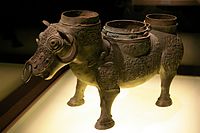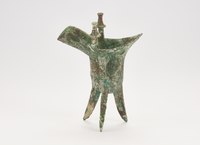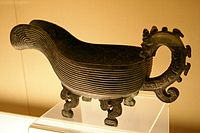
The Shang dynasty, also known as the Yin dynasty, was a Chinese royal dynasty that ruled in the Yellow River valley during the second millennium BC, traditionally succeeding the Xia dynasty and followed by the Western Zhou dynasty. The classic account of the Shang comes from texts such as the Book of Documents, Bamboo Annals and Shiji. Modern scholarship dates the dynasty between the 16th and 11th centuries BC, with more agreement surrounding the end date than beginning date.
The Western Zhou was a period of Chinese history corresponding roughly to the first half of the Zhou dynasty. It began when King Wu of Zhou overthrew the Shang dynasty at the Battle of Muye and ended in 771 BC when Quanrong pastoralists sacked the Zhou capital at Haojing and killed King You of Zhou. The "Western" label for the period refers to the location of the Zhou royal capitals, which were clustered in the Wei River valley near present-day Xi'an.

The zun or yi, used until the Northern Song (960–1126) is a type of Chinese ritual bronze or ceramic wine vessel with a round or square vase-like form, sometimes in the shape of an animal, first appearing in the Shang dynasty. Used in religious ceremonies to hold wine, the zun has a wide lip to facilitate pouring. Vessels have been found in the shape of a dragon, an ox, a goose, and more. One notable zun is the He zun from the Western Zhou.
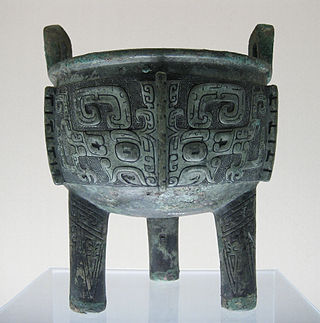
Ding are prehistoric and ancient Chinese cauldrons standing upon legs with a lid and two fancy facing handles. They are one of the most important shapes used in Chinese ritual bronzes. They were made in two shapes: round vessels with three legs and rectangular ones with four, the latter often called fāng dǐng. They were used for cooking, storage, and ritual offerings to the gods or to ancestors.

A guang or gong is a particular shape used in Chinese art for vessels, originally made as Chinese ritual bronzes in the Shang dynasty, and sometimes later in Chinese porcelain. They are a type of ewer which was used for pouring rice wine at ritual banquets, and often deposited as grave goods in high-status burial. Examples of the shape may be described as ewers, ritual wine vessels, wine pourers and similar terms, though all of these terms are also used of a number of other shapes, especially the smaller tripod jue and the larger zun.
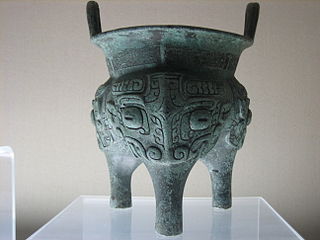
The taotie is an ancient Chinese mythological creature that was commonly emblazoned on bronze and other artifacts during the 1st millennium BCE. Taotie are one of the Four Perils in Chinese classics like the Classic of Mountains and Seas, alongside the Hundun, Qiongqi, and Taowu.
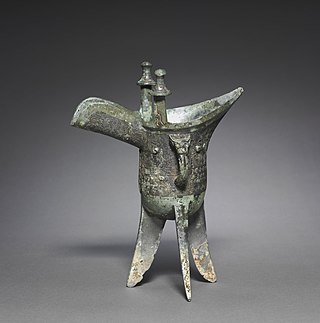
A jue is a type of ancient Chinese ritual bronze vessel used to serve warm wine during ancestor-worship ceremonies. It takes the form of an ovoid body supported by three splayed triangular legs, with a long curved spout on one side and a counterbalancing flange on the other. Many examples have one or two loop handles on the side and two column-shaped protuberances on the top of the vessel, which were probably used to enable the vessel to be lifted using leather straps. They are often ornately decorated with taotie decorations representing mythical beasts. They are in effect a small Chinese equivalent of the ewer. The name jue is not original, but derives from the Shuowen Jiezi, a dictionary of the 2nd century AD.

A hu is a type of wine vessel that has a pear-shaped cross-section. Its body swells and flares into a narrow neck, creating S-shaped profile. While it is similar to you vessel, hu usually has a longer body and neck. The shape of hu probably derives from its ceramic prototype prior to the Shang dynasty. They usually have handles on the top or rings attached to each side of neck. Many extant hu lack lids while those excavated in such tombs as Fu Hao's indicate that this type of vessel might be originally made with lids. Although it is more often to see hu having a circular body, there also appears hu in square and flat rectangular forms, called fang hu and bian huArchived 2015-09-23 at the Wayback Machine in Chinese. In addition, hu often came to be found in a pair or in a set together with other types of vessels. As wine had played an important part in the Shang ritual, the hu vessel might be placed in the grave of an ancestor as part of ritual in order to ensure a good relationship with ancestor's spirit.

A jia is a ritual vessel type found in both pottery and bronze forms; it was used to hold libations of wine for the veneration of ancestors. It was made either with four legs or in the form of a tripod and included two pillar-like protrusions on the rim that were possibly used to suspend the vessel over heat. The earliest evidence of the Jia vessel type appears during the Neolithic Period. It was a prominent form during the Shang and early Western Zhou dynasties, but had disappeared by the mid-Western Zhou.

A dui is a type of Chinese ritual bronze vessel used in the late Zhou dynasty and the Warring States period of ancient China. It was a food container used as a ritual vessel. Most dui consist of two bowls supported on three legs.

A gu is a type of ancient Chinese ritual bronze vessel from the Shang and Zhou dynasties. It was used to drink wine or to offer ritual libations.
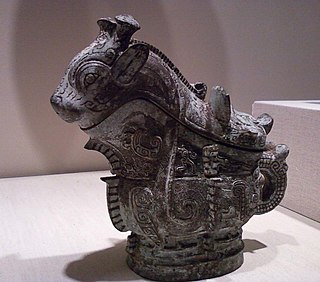
An elaborately decorated "ritual wine server" in the guang shape is a Chinese ritual bronze wine vessel, accession number 60.43, in the permanent Asian collection at the Indianapolis Museum of Art. It dates to about 1100 BCE in the Shang dynasty period. The piece is currently on display in the Arthur R. & Frances D. Baxter Gallery of the museum.

The Shi Qiang pan is a Chinese bronze dated to the end of the 10th century BCE. It is inscribed with a text that has been described as "the first conscious attempt in China to write history". It is regarded as one of China's national treasures, and was listed in 2002 as one of sixty-four cultural relics forbidden to be exhibited abroad. It is kept at the Baoji Bronzeware Museum; a replica is displayed in the Calgary Chinese Cultural Centre Museum. The vessel is low and round, and has two handles. It is 16.2 cm (6.4 in) tall, and has a diameter of 47.3 cm (18.6 in). Its exterior is cast with a taotie design.
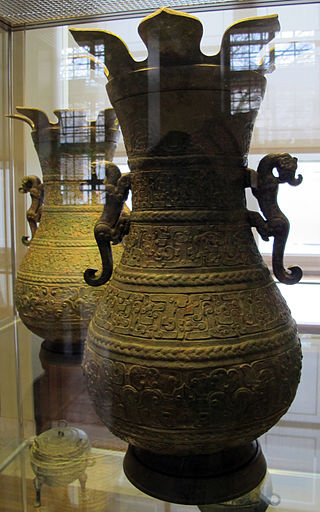
The Huixian Bronze Hu are a pair of bronze wine vessels that were found in the city of Huixian, Henan province, central China. Dating to the Eastern Zhou dynasty, they have been part of the British Museum's Asian Collections since 1972.

The Li gui is an ancient Chinese bronze sacrificial gui vessel cast by an early Zhou dynasty official.

A fangyi is a type of Chinese ritual bronze container typical of the Shang and early to middle Zhou periods of Bronze Age China. It takes the shape of a square or rectangular casket with a cover that resembles a hip roof, surmounted by a knob of a similar hipped appearance. The lower edge is typically indented with a semi-circular notch.

The Fu Hao owl zun are a pair of two zun vessels from the Chinese Shang dynasty discovered in 1976 in the Tomb of Fu Hao, at Yinxu in present-day Anyang, Henan. Considered a prominent example of the usage of the owl motif in Shang dynasty ritual bronzes, the works are now held by the Henan Museum and the National Museum of China.
The Fujita Ram Gong is a Shang dynasty Chinese ritual bronze vessel, a guang, in the shape of a ram that dates to the later part of the dynasty in 13th-11th century B.C. Considered significant for its realistic shape and style, it is among 13 known Chinese bronze vessels made in animal-form.
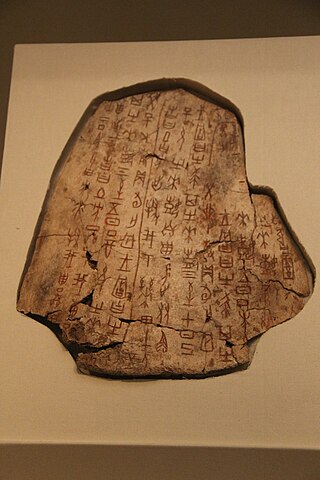
The state religion of the Shang dynasty involved trained practitioners communicating with deities, including deceased ancestors and nature spirits. These deities formed a pantheon headed by the high god Di. Methods of communication with spirits included divinations inscribed on oracle bones and sacrifice of living beings. Much of what is known about Shang religion has been discovered through archaeological work at Yinxu – the site of Yin, the final Shang capital – among other sites. At Yinxu, artefacts such as oracle bones and ritual bronze vessels have been excavated. The earliest attested inscriptions were made c. 1250 BC, during the reign of King Wu Ding – though the attested script is fully mature, and is believed to have emerged significantly earlier.
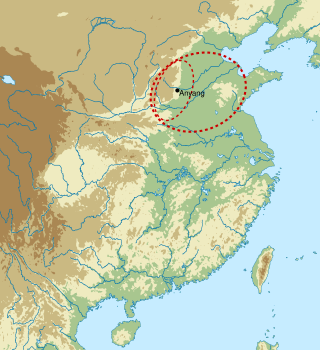
The Late Shang, also known as the Anyang period, is the earliest known literate civilization in China, spanning the reigns of the last nine kings of the Shang dynasty, beginning with Wu Ding in the second half of the 13th century BC and ending with the conquest of the Shang by the Zhou in the mid-11th century BC. The state is known from artifacts recovered from its capital at a site near Anyang now known as Yinxu and other sites across the North China Plain. One of the richest finds was the Tomb of Fu Hao at Yinxu, thought to belong to a consort of Wu Ding mentioned in Shang inscriptions.









